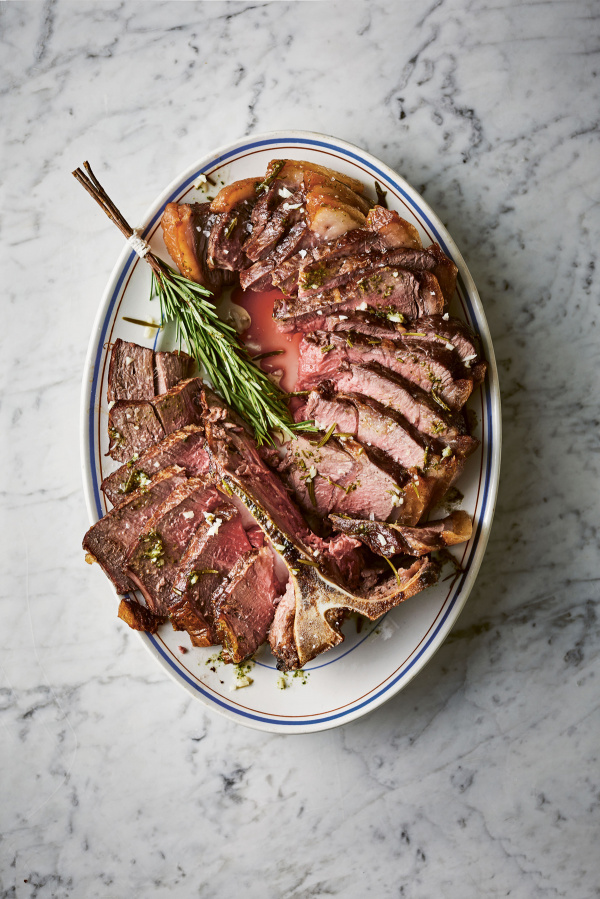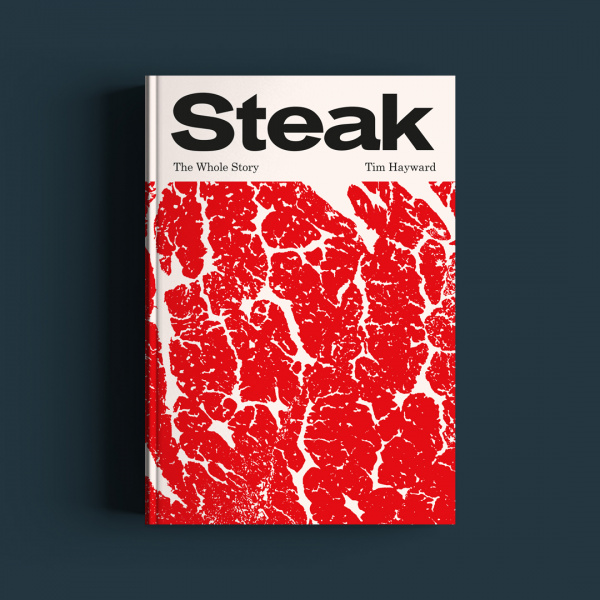Bistecca Alla Fiorentina
by Tim Hayward, featured in Steak: The Whole Story Published by QuadrilleIntroduction
A bistecca alla Fiorentina is so good that it needs almost no intervention. Under the right circumstances, you can just cook it and sprinkle it with salt. Those circumstances, though, would be a wood-fired oven, a griddle and a small trattoria in Florence that’s been in the family for three generations. For complete authenticity, it would also require the best porterhouse steak cut from a fully grown Chianina ox, measuring three or four fingers thick. Not easy to replicate.
The Fiorentina is ideal for cooking on a big barbecue or grill, as long as the temperature is controllable — you need to be able to drop it fast and accurately — and the top can be closed. If you do this, sear the steak directly on the grill first, then finish it in a pan placed on the grill. A small amount of oak or other aromatic wood would not be inappropriate.
For a small dinner party or a special family meal, a Fiorentina is little sort of magical. Visually, it makes a stunning centrepiece. It’s an absolute breeze to carve and then, on the plate, there are big, equal-size chunks of chewy, strong flavoured sirloin and lean, subtle fillet, all perfectly finished. There’s plenty of excellent fat for those who like it and an incredible blend of meat juice and garlicky, herby oil to lubricate everything.
It’s not a cheap cut but of all the grandest steaks, this is the one that will convince your guests that when meat is this good, you don’t need so much.
A bistecca alla Fiorentina is so good that it needs almost no intervention. Under the right circumstances, you can just cook it and sprinkle it with salt. Those circumstances, though, would be a wood-fired oven, a griddle and a small trattoria in Florence that’s been in the family for three generations. For complete authenticity, it would also require the best porterhouse steak cut from a fully grown Chianina ox, measuring three or four fingers thick. Not easy to replicate.
The Fiorentina is ideal for cooking on a big barbecue or grill, as long as the temperature is controllable — you need to be able to drop it fast and accurately — and the top can be closed. If you do this, sear the steak directly on the grill first, then finish it in a pan placed on the grill. A small amount of oak or other aromatic wood would not be inappropriate.
For a small dinner party or a special family meal, a Fiorentina is little sort of magical. Visually, it makes a stunning centrepiece. It’s an absolute breeze to carve and then, on the plate, there are big, equal-size chunks of chewy, strong flavoured sirloin and lean, subtle fillet, all perfectly finished. There’s plenty of excellent fat for those who like it and an incredible blend of meat juice and garlicky, herby oil to lubricate everything.
It’s not a cheap cut but of all the grandest steaks, this is the one that will convince your guests that when meat is this good, you don’t need so much.

Share or save this
Ingredients
Serves: 2-4
- 1 large extra-thick porterhouse steak
- 1 bunch of rosemary
- 1 bunch of sage
- 150 millilitres olive oil
- 4 cloves of garlic (roughly chopped sea salt and freshly ground black pepper)
- rocket and Parmesan salad to serve (optional)
- 1 large extra-thick porterhouse steak
- 1 bunch of rosemary
- 1 bunch of sage
- 5 fluid ounces olive oil
- 4 cloves of garlic (roughly chopped sea salt and freshly ground black pepper)
- arugula and Parmesan salad to serve (optional)
Method
Bistecca Alla Fiorentina is a guest recipe by Tim Hayward so we are not able to answer questions regarding this recipe
- The night before you want to cook, season the meat all over with salt and pepper and place on a wire rack set over a tray. Pack some of the herbs around the meat, then transfer to the fridge to rest overnight, uncovered.
- Pour the oil into a saucepan and add the garlic. Roughly chop some more of the herbs (a couple of handfuls), reserving some for tomorrow, and add to the oil. Warm the oil over a low heat for about 30 minutes — don’t allow it to boil or simmer. You want to infuse the flavours into the oil rather than cook them out. Strain the oil into a container and set aside.
- The next day, preheat the oven to its highest setting. Put a cast-iron frying pan into the oven to get hot.
- Tie the remaining herbs into a bundle to use as a brush.
- Brush the marinade herbs and garlic off the steak and pat it dry with paper towels if necessary. Transfer the hot pan to the hob and sear the steak on both sides over a high heat.
- Stand the steak up on the bone and brush the outside of the steak with the infused oil using your herb ‘brush’. Fling a couple of pinches of salt at the sides so that some sticks to the oil. If you have a wireless probe thermometer, insert it now. Place the pan (with the steak still standing on its side) into the hot oven.
- Allow the oven to come back up to temperature, then reduce the heat to 150°C (300°F/Gas 2).
- After 10 minutes, open the door and baste the steak, using more of the infused oil and anything you can mop up from the pan. Check the core temperature.
- Continue basting and checking until the core temperature reaches 56°C (133°F), then remove the steak from the oven and set it aside to rest. Italians traditionally prefer to eat their food at lower temperatures, so a really long rest is not a bad idea, plus you can continue basting throughout.
- Serve with extra salt and an extremely simple salad, perhaps rocket dressed with olive oil, salt and lemon and, if you feel outrageously extravagant, some shavings of good-quality Parmesan.
- The night before you want to cook, season the meat all over with salt and pepper and place on a wire rack set over a tray. Pack some of the herbs around the meat, then transfer to the fridge to rest overnight, uncovered.
- Pour the oil into a saucepan and add the garlic. Roughly chop some more of the herbs (a couple of handfuls), reserving some for tomorrow, and add to the oil. Warm the oil over a low heat for about 30 minutes — don’t allow it to boil or simmer. You want to infuse the flavours into the oil rather than cook them out. Strain the oil into a container and set aside.
- The next day, preheat the oven to its highest setting. Put a cast-iron frying pan into the oven to get hot.
- Tie the remaining herbs into a bundle to use as a brush.
- Brush the marinade herbs and garlic off the steak and pat it dry with paper towels if necessary. Transfer the hot pan to the hob and sear the steak on both sides over a high heat.
- Stand the steak up on the bone and brush the outside of the steak with the infused oil using your herb ‘brush’. Fling a couple of pinches of salt at the sides so that some sticks to the oil. If you have a wireless probe thermometer, insert it now. Place the pan (with the steak still standing on its side) into the hot oven.
- Allow the oven to come back up to temperature, then reduce the heat to 150°C (300°F/Gas 2).
- After 10 minutes, open the door and baste the steak, using more of the infused oil and anything you can mop up from the pan. Check the core temperature.
- Continue basting and checking until the core temperature reaches 56°C (133°F), then remove the steak from the oven and set it aside to rest. Italians traditionally prefer to eat their food at lower temperatures, so a really long rest is not a bad idea, plus you can continue basting throughout.
- Serve with extra salt and an extremely simple salad, perhaps arugula dressed with olive oil, salt and lemon and, if you feel outrageously extravagant, some shavings of good-quality Parmesan.






Tell us what you think
Thank you {% member.data['first-name'] %}.
Explore more recipesYour comment has been submitted.